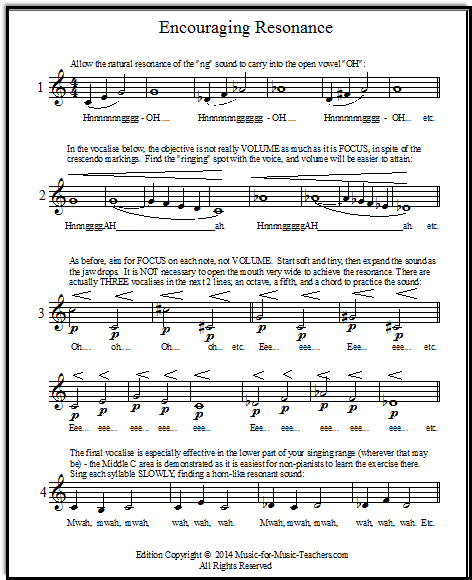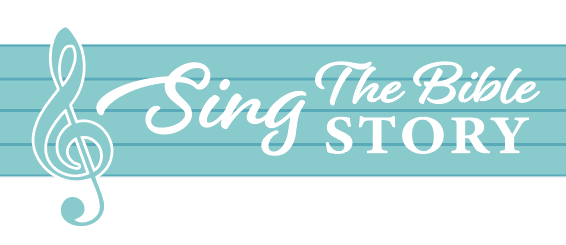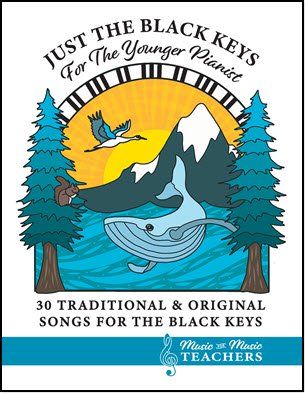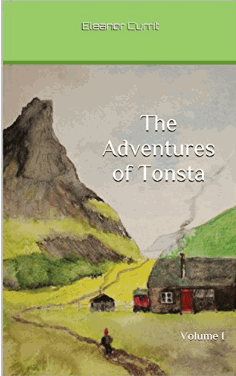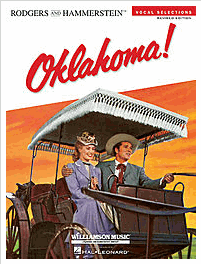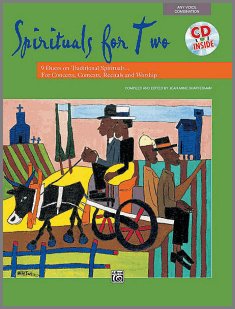Vocalises for Beginners:
Encouraging Resonance
Vocalises for beginners need to teach them how to execute vocal TECHNIQUE, not just stretch their muscles with a warmup.
Quiet little voices need to learn how to find RESONANCE in their tone... see if these vocalises will help!
Here are what the "Encouraging Resonance" warm-ups look like
Please scroll down the page for the free download link.
Many of your beginning vocal students will come to you with soft voices that will not carry beyond the first row of the church pews.
That's not necessarily bad; at least they're not shouting, which could hurt their singing muscles!
Tone placement
This is an opportunity to train them to achieve volume correctly, by tone placement instead of by using lung power!
What you are after is singing with resonance.
First of all, they need to know that you are after a certain kind of sound! Imagine a mosquito, buzzing around their ears... I like to use this sound a lot, when giving singers an example of what I am after.
The "mosquito" trick: find your note and start it with a tiny sound, then "swell" it. But before opening up big with the sound, focus it. Find the bell-like tone that comes from placing the sound where it can "ping".
What? How? Well, it takes practice, and much exaggeration of vocalise exercises to reliably be able to find that focused sound again and again.
Be the mosquito
I like to to employ the mosquito effect by singing with the student on a sound halfway between a closed "Hnng" and an open "Huh". I make a hand gesture - my pinched finger and thumb flying around the student, pretending to be a mosquito.
As the imaginary mosquito swoops first nearer, then farther, its whiny volume (which is I, singing "hnng") increases and decreases again. This is not a pretty sound. However, the irritating sound is very focused and resonant!
"Whining" together
This whining sound is easy for my vocal student to imitate. We whine together for a little bit.
Then, we go to our song, and try to put this sound into the song. We find our trouble note, achieve the ringing mosquito noise, but then drop the jaw for BIGGER, more normal, singing sound - and now we have resonance in singing.
Another way to think about resonance is to imagine that singing is all taking place in the HEAD, back behind the ears. Think of the sound resonating inside there, vibrating in the skull.
And another technique: Take an almond, or a cinnamon stick, or even a pen or pencil, and bite down on it with the back teeth. This creates space automatically. And VOLUME.
Now sing "Eeeee... " The position of the jaw should result in a slightly different sound than the student is used to; LOUDER, more resonant; a sound that can carry easily. This greater volume should happen without breathiness or pushing.
"Eee" is usually my favorite vowel for practicing resonance, but all of them should be used. From bright to dark, they are "ee, eh (ay), ah, oh, oo..."
Going through the break with continuing resonance is especially difficult! Don't abandon these vocalises, or your own version of them, in a hurry!
The link for the vocalise page:
Download Vocalises for Beginners sheet "Encouraging Resonance"
Dianna:
Your website is a light in the darkness. THANK YOU for all you do in helping to spread the love of music. It matters!
Recent Articles
-
Singing In a Round: "Come Away" Has Six Possible Parts!
Singing in a round is a fun challenge for voice students! This pretty song, "Come Away," can be sung with as few as 2 voices, or as many as 6. Free PDFs!! -
How to Teach Voice Lessons for the First-Time Teacher
How to teach voice lessons, when you are a beginning teacher? Get some tips to quell your fears at this new venture! Warmups, rounds, duets, & solos, free! -
Find Home School & Other Students, & Teach Them Music!
Let me give you suggestions on how to find music students in a new town. Parents want qualified, fun teachers for their kids - meet them where they are! -
Traditional Irish Sheet Music: White, Orange & Green
Free Irish sheet music, the beautiful White, Orange, & Green tells the story of a daring young Irish girl, who defends her country's flag! -
Vocalises for Beginners: Encouraging Them to Sing With Resonance!
Vocalises for beginners to help them sing with resonance. Encourage students to imitate weird but useful sounds to bring "ringiness" to their voice!
Interested in songs from the Bible for your students or church? Check out my other website, SingTheBibleStory.com!
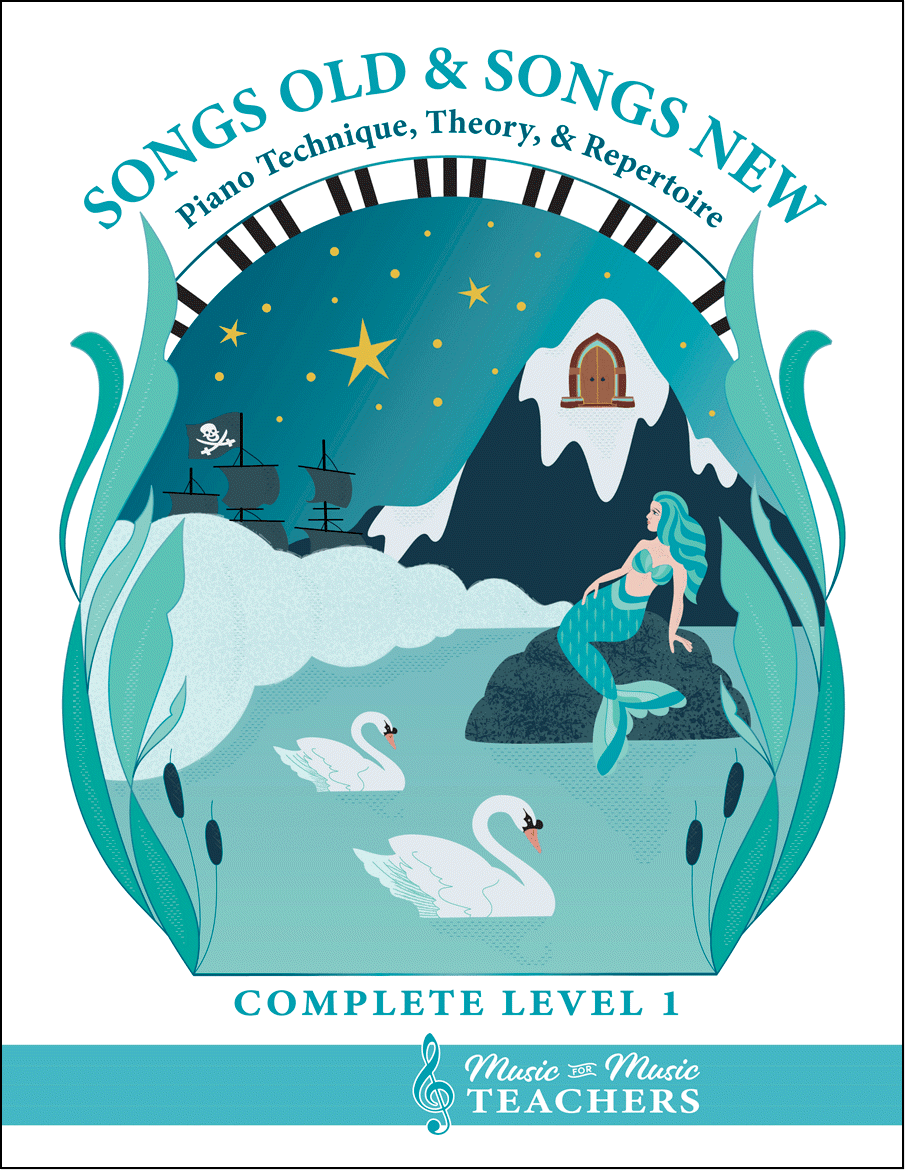
All the first-year material I give my beginner students.
Piano keyboard sheets, scales, chords, note-reading exercises, and over 256 pages of music!
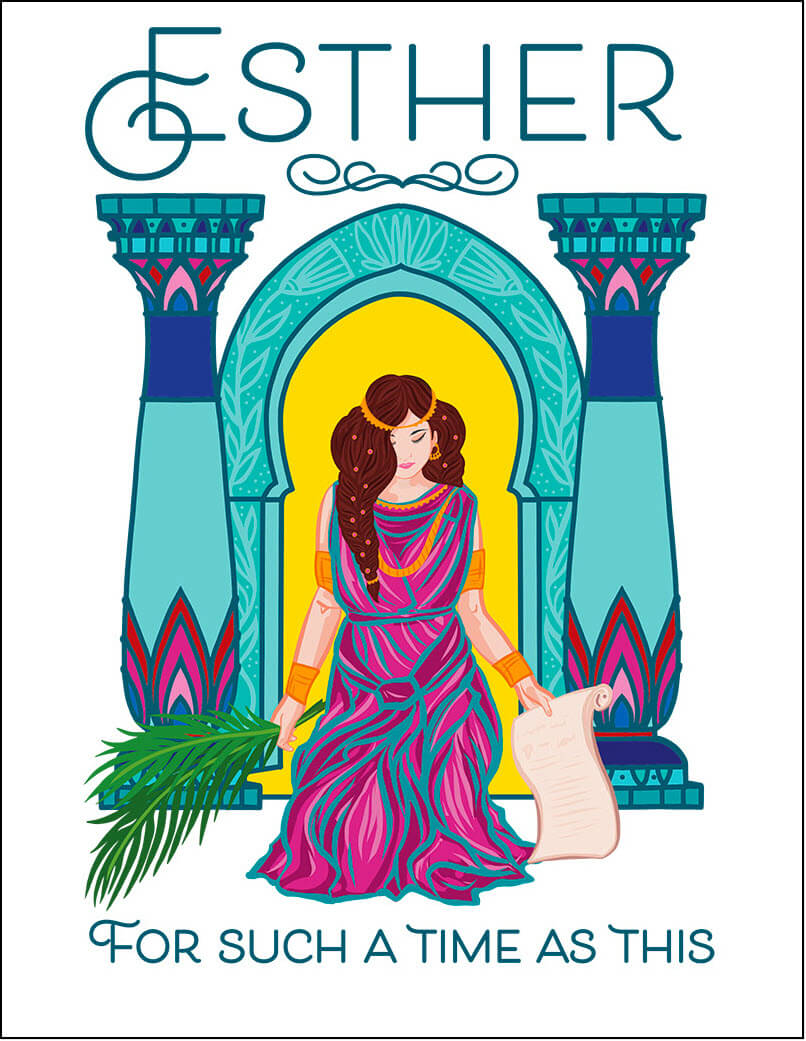
This beautiful song book for piano & voice "Esther, For Such a Time as This", available as a digital download, tells the riveting story of the time when Jews in ancient Persia faced a foe named Haman, and how a brave young queen risked her life to save her people.
A good choice for a singing story-teller, an operatic group, a short theater production, or a class of children!
This book is also available from Amazon as a paperback.
This book is available as a digital download from this site. Visit this page to see some free examples from the book.
It is also available from Amazon as a paperback!
This is the perfect easy start for little pianists.
And when they start reading white-key notes on the staff, this is a fun easy resource to say each week, "Choose a new black-key song at home this week and figure it out to show me next lesson!" They will be spending more time at the piano.
A perfect read aloud storybook
for little boys or girls.
The Adventures of Tonsta highlight the travels of a very young boy with a good heart, who goes about helping folk in trouble.
With a red cap on his head and a sack of tools slung over his shoulder, Tonsta seems to meet people in distress wherever he goes.
Lots of trolls in this book - including one who gives him a Christmas gift!
Carrie,Voice and Piano Teacher:
This site is FABULOUS.
For all the reasons you explain on the site itself--this is exactly what piano teachers need! (I still need to go look at the vocal music). Wow. THANK YOU SO MUCH!
Marta:
Thank you for the free downloads! I'm a private teacher and I teach piano and beginner voice as well. :)
I've been running my studio for about a year and I've come across the same issue; I don't want my students to have to purchase an entire supplemental book for only a couple of songs. So thank you for this site...some great downloads!!
Ruth:
Thanks, Dana, for your excellent customer service.
Amber:
Thank you! THANK YOU!!! For keeping the beautiful art of Opera alive! I stumbled upon this site and I'm so happy I did!
About the Author

Hi, I'm Dana! (Say that like "Anna".) I'm the owner of Music-for-Music-Teachers.com, and a newer site, SingTheBibleStory.com.
Like some of you, I've been playing the piano since early childhood, and have added a few other instruments along the way, plus an interest in arranging and composing music.
You can find out more about me and the reason for this website at my About Me page.
